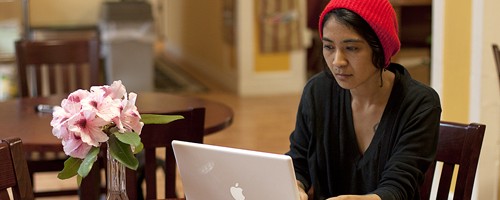We received this letter to the editor from a concerned reader who ran into issues on campus with his guide dog. His advice is quite valuable, so we’ve printed the entire letter for your information. Consider it a part of your education at PSU.
Dear Editor:
I would like to address the students and faculty of the Portland State University campus.
There have been several incidents which have occurred to me while walking with my guide dog Bryson which makes me feel that perhaps a note regarding the proper protocol or etiquettes when dealing with a guide dog team (the guide dog and the handler).
First and foremost, I am grateful for the kindness and compassion that many students and faculty here at PSU have given me and my guide dog, Bryson. I honestly feel that some of the incidents which have occurred are merely attributable to just not knowing how to properly handle a particular situation involving a guide dog.
One issue in particular seems to be more frequent and has caused both me and Bryson problems. People are cutting in front of us while we’re either walking from building to building, in the halls, or approaching a street curb. When this occurs, it not only startles Bryson and I, it can cause him to lose focus and perhaps puts both of us in harm’s way. The best approach to handling this situation would be to announce yourself and that you need to get ahead of us. This way, both Bryson and I can be aware of your intentions and expect that you’ll be coming around us.
The following is a list of etiquettes regarding guide dogs which I was able to locate on the Guide Dog for the Blind website (www.guidedogs.com):
■ As tempting as it may be to pet a Guide Dog, remember that this dog is responsible for leading someone who cannot see. The dog should never be distracted from that duty. A person’s safety may depend on their dog’s alertness and concentration.
■ It is okay to ask someone if you may pet their guide. Many people enjoy introducing their dogs when they have the time. The dog’s primary responsibility is to its blind partner and it is important that the dog not become solicitous.
■ A Guide Dog should never be offered food or other distracting treats. The dogs are fed on a schedule and follow a specific diet in order to keep them in optimum condition. Even slight deviations from their routine can disrupt their regular eating and relieving schedules and seriously inconvenience their handlers. Guide Dogs are trained to resist offers of food so they will be able to visit restaurants without begging. Feeding treats to a Guide Dog weakens this training.
■ Although Guide Dogs cannot read traffic signals, they are responsible for helping their handlers safely cross a street. Calling out to a Guide Dog or intentionally obstructing its path can be dangerous for the team as it could break the dog’s concentration on its work.
■ Listening for traffic flow has become harder for Guide Dog handlers due to quieter car engines and the increasing number of cars on the road. Please don’t honk your horn or call out from your car to signal when it is safe to cross. This can be distracting and confusing. Be especially careful of pedestrians in crosswalks when making right-hand turns at red lights.
■ It’s not all work and no play for a Guide Dog. When they are not in harness, they are treated in much the same way as pets. However, for their safety they are only allowed to play with specific toys. Please don’t offer them toys without first asking their handler’s permission.
■ In some situations, working with a Guide Dog may not be appropriate. Instead, the handler may prefer to take your arm just above the elbow and allow their dog to heel. Others will prefer to have their dog follow you. In this case, be sure to talk to the handler and not the dog when giving directions for turns.
■ A Guide Dog can make mistakes and must be corrected in order to maintain its training. This correction usually involves a verbal admonishment coupled with a leash correction, followed by praise when the dog regains focus and correctly follows a command. Guide Dog handlers have been taught the appropriate correction methods to use with their dogs.
■ Before asking a question of a person handling a dog, allow them to complete the task at hand.
■ Remain calm in your approach and mannerisms.
■ Never tease a dog.
For those whom may be curious, Bryson has 3 other siblings that he plays with when he gets home. It may appear that he’s all work and no play but trust me, he gets PLENTY of attention and play time. When he arrives home from a stressful day of work, I take his leash and harness off and all of a sudden, he’s Bryson, the playful pup. He runs and plays with the others.
Thank you for taking the time to read this and please, if and when an opportunity presents itself, do introduce yourselves to me and if time and circumstances permits it, I would be happy to introduce you to Bryson.
Sincerely,
Terry Blosser



